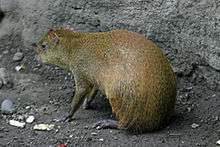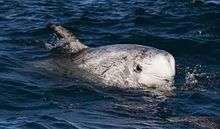List of mammals of the Cayman Islands
This is a list of the mammal species recorded in the Cayman Islands. There are the mammal species in the Cayman Islands, of which one is believed to be threatened.[1]
The following tags are used to highlight each species' conservation status as assessed by the IUCN:
| EX | Extinct | No reasonable doubt that the last individual has died. |
| EW | Extinct in the wild | Known only to survive in captivity or as a naturalized populations well outside its previous range. |
| CR | Critically Endangered | The species is in imminent risk of extinction in the wild. |
| EN | Endangered | The species is facing an extremely high risk of extinction in the wild. |
| VU | Vulnerable | The species is facing a high risk of extinction in the wild. |
| NT | Near Threatened | The species does not meet any of the criteria that would categorise it as risking extinction but it is likely to do so in the future. |
| LC | Least Concern | There are no current identifiable risks to the species. |
| DD | Data Deficient | There is inadequate information to make an assessment of the risks to this species. |
Subclass: Theria
Infraclass: Eutheria
Order: Chiroptera (bats)
The bats' most distinguishing feature is that their forelimbs are developed as wings, making them the only mammals in the world naturally capable of flight. Bat species account for about 20% of all mammals.
- Family: Molossidae
- Genus: Molossus
- Velvety free-tailed bat Molossus molossus LC
- Genus: Tadarida
- Mexican free-tailed bat Tadarida brasiliensis LC
- Genus: Molossus
- Family: Phyllostomidae
- Subfamily: Phyllostominae
- Genus: Macrotus
- Waterhouse's leaf-nosed bat Macrotus waterhousii LC
- Genus: Macrotus
- Subfamily: Brachyphyllinae
- Genus: Brachyphylla
- Cuban fruit-eating bat Brachyphylla nana NT
- Genus: Brachyphylla
- Subfamily: Phyllonycterinae
- Genus: Erophylla
- Buffy flower bat Erophylla sezekorni LC
- Genus: Erophylla
- Subfamily: Stenodermatinae
- Genus: Artibeus
- Jamaican fruit bat Artibeus jamaicensis LC
- Genus: Phyllops
- Cuban fig-eating bat Phyllops falcatus LC
- Genus: Artibeus
- Family: Vespertilionidae
- Genus: Eptesicus
- Big brown bat Eptesicus fuscus LC
- Genus: Eptesicus
- Subfamily: Phyllostominae
Order: Rodentia (Rodents)
Rodentia is an order of mammals characterised by two continuously growing incisors in the upper and lower jaws which must be kept short by gnawing.[2][3] Forty percent of mammal species are rodents, and they are found in vast numbers on all continents other than Antarctica. Rodents have sharp incisors that they use to gnaw wood, break into food, and bite predators. Most eat seeds or plants, though some have more varied diets. Some species have historically been pests, eating seeds stored by people[4] and spreading disease.[5]
The name comes from the Latin word rodens, "gnawing one" (from the verb rodere, "gnaw").
In terms of number of species—although not necessarily in terms of number of organisms (population) or biomass—rodents make up the largest order of mammals. There are about 2,277 species of rodents (Wilson and Reeder, 2005), with over 40 percent of mammalian species belonging to the order.[6]
The Central American agouti has been introduced to the Cayman Islands, and are found in forests, thick brush, savannas, and cultivated areas.
- Family: Dasyproctidae
- Genus: Dasyprocta
- Species: Dasyprocta punctata, Central American agouti (I) LC
- Genus: Dasyprocta
Order: Cetacea (whales)
The order Cetacea includes whales, dolphins and porpoises. They are the mammals most fully adapted to aquatic life with a spindle-shaped nearly hairless body, protected by a thick layer of blubber, and forelimbs and tail modified to provide propulsion underwater.
- Suborder: Mysticeti
- Family: Balaenopteridae (baleen whales)
- Genus: Balaenoptera
- Common minke whale Balaenoptera acutorostrata
- Sei whale Balaenoptera borealis
- Bryde's whale Balaenoptera brydei
- Blue whale Balaenoptera musculus
- Genus: Megaptera
- Humpback whale Megaptera novaeangliae
- Genus: Balaenoptera
- Family: Balaenopteridae (baleen whales)
- Suborder: Odontoceti
- Superfamily: Platanistoidea
- Family: Delphinidae (marine dolphins)
- Genus: Delphinus
- Short-beaked common dolphin Delphinus delphis DD
- Genus: Feresa
- Pygmy killer whale Feresa attenuata DD
- Genus: Globicephala
- Short-finned pilot whale Globicephala macrorhyncus DD
- Genus: Lagenodelphis
- Fraser's dolphin Lagenodelphis hosei DD
- Genus: Grampus
- Risso's dolphin Grampus griseus DD
- Genus: Orcinus
- Killer whale Orcinus orca DD
- Genus: Peponocephala
- Melon-headed whale Peponocephala electra DD
- Genus: Pseudorca
- False killer whale Pseudorca crassidens DD
- Genus: Stenella
- Pantropical spotted dolphin Stenella attenuata DD
- Clymene dolphin Stenella clymene DD
- Striped dolphin Stenella coeruleoalba DD
- Atlantic spotted dolphin Stenella frontalis DD
- Spinner dolphin Stenella longirostris DD
- Genus: Steno
- Rough-toothed dolphin Steno bredanensis DD
- Genus: Tursiops
- Common bottlenose dolphin Tursiops truncatus
- Genus: Delphinus
- Family: Physeteridae (sperm whales)
- Genus: Physeter
- Sperm whale Physeter catodon (DD)
- Genus: Physeter
- Family: Kogiidae (dwarf sperm whales)
- Genus: Kogia
- Pygmy sperm whale Kogia breviceps (DD)
- Dwarf sperm whale Kogia sima (DD)
- Genus: Kogia
- Family: Delphinidae (marine dolphins)
- Superfamily Ziphioidea
- Family: Ziphidae (beaked whales)
- Genus: Mesoplodon
- Gervais' beaked whale Mesoplodon europaeus (DD)
- Genus: Ziphius
- Cuvier's beaked whale Ziphius cavirostris (DD)
- Genus: Mesoplodon
- Family: Ziphidae (beaked whales)
- Superfamily: Platanistoidea
Order: Carnivora (carnivorans)
There are over 260 species of carnivorans, the majority of which feed primarily on meat. They have a characteristic skull shape and dentition.
- Suborder: Pinnipedia
- Family: Phocidae (earless seals)
- Genus: Monachus
- Caribbean monk seal Monachus tropicalis EX
- Genus: Monachus
- Family: Phocidae (earless seals)
Notes
- ↑ This list is derived from the IUCN Red List which lists species of mammals and includes those mammals that have recently been classified as extinct (since 1500 AD). The taxonomy and naming of the individual species is based on those used in existing Wikipedia articles as of 21 May 2007 and supplemented by the common names and taxonomy from the IUCN, Smithsonian Institution, or University of Michigan where no Wikipedia article was available.
- ↑ "rodent - Encyclopedia.com". Retrieved 2007-11-03.
- ↑ "Rodents: Gnawing Animals". Retrieved 2007-11-03.
- ↑ Meerburg BG, Singleton GR, Leirs H (2009). "The Year of the Rat ends: time to fight hunger!". Pest Manag Sci. 65 (4): 351–2. doi:10.1002/ps.1718. PMID 19206089.
- ↑ Meerburg BG, Singleton GR, Kijlstra A (2009). "Rodent-borne diseases and their risks for public health". Crit Rev Microbiol. 35 (3): 221–70. doi:10.1080/10408410902989837. PMID 19548807.
- ↑ Myers, Phil (2000). "Rodentia". Animal Diversity Web. University of Michigan Museum of Zoology. Retrieved 2006-05-25.
References
- "The IUCN Red List of Threatened Species: Mammals of the Cayman Islands". IUCN. 2001. Retrieved 22 May 2007.
- "Mammal Species of the World". Smithsonian National Museum of Natural History. 2005. Archived from the original on 27 April 2007. Retrieved 22 May 2007.
- "Animal Diversity Web". University of Michigan Museum of Zoology. 1995–2006. Retrieved 22 May 2007.
See also
- List of chordate orders
- List of regional mammals lists
- List of prehistoric mammals
- Mammal classification
- New mammal species

